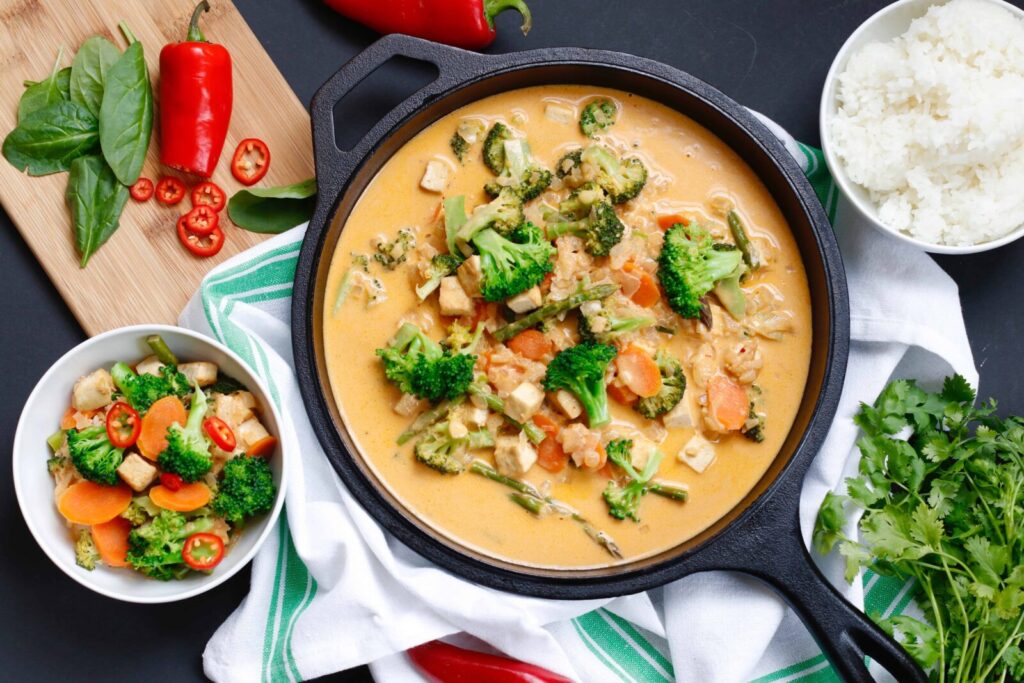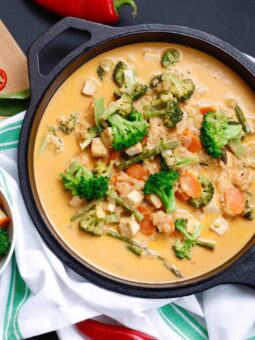The BEST Red Thai Vegetable Curry
Try this bright and beautifully balanced Red Thai Vegetable Curry. Perfectly cooked veggies are coated in the loveliest lemon-laced and ginger-traced coconut curry sauce.
If you’re into coconut recipes by the way, you need to checkout my chickpea coconut curry!

Why you’ll love this Thai vegetable curry recipe
- It’s packed with flavor: Thai cuisine is known for its bold and vibrant flavors. This particular recipe is well-balanced which is key to any good Thai curry.
- It’s vegan and healthy: A vegetable curry is a great way to get in a variety of nutritious vegetables, and when made with coconut milk, it’s also vegan and dairy-free. Plus, the spices and herbs used in Thai cuisine have been linked to a range of health benefits, including reduced inflammation and improved digestion.
- It’s customizable: You can use a variety of different vegetables in a Thai vegetable curry, depending on your preferences and what’s in season. You can also adjust the level of spiciness to your liking, and add in other ingredients like tofu or chickpeas for added protein.
- It’s easy to make: While the ingredient list for a Thai vegetable curry may seem long, the actual preparation is fairly straightforward. Once you’ve gathered your ingredients, it’s mostly a matter of chopping and sautéing the vegetables, then simmering everything together in the curry sauce.
- It’s comforting and satisfying: A warm and comforting bowl of vegetable curry is the perfect meal for a cold or rainy day, and it’s also satisfying enough to serve as a main course. Plus, leftovers can be reheated easily for a quick and delicious meal throughout the week.
Ingredients and substitution notes
- Onion: The onion provides a base flavor for the curry.
- Olive oil: The olive oil is used to sauté the onion and ginger. You could also use another neutral oil, like vegetable or avocado.
- Grated ginger: Fresh ginger adds a bright and slightly spicy flavor to the curry.
- Red curry paste: The curry paste is the main source of flavor and spice in the curry. You could use green or yellow curry paste if you prefer.
- Coconut milk: The coconut milk adds a rich and creamy texture to the curry. You could use light coconut milk if you’re watching your calorie intake.
- Bragg Liquid Aminos (soy sauce): Braggs is a type of soy sauce that is lower in sodium than traditional soy sauce. If you don’t have Braggs, you could use regular soy sauce or tamari.
- Lemon juice: The lemon juice adds a tangy flavor to the curry. You could also use lime juice.
- Carrot: The carrot adds a bit of sweetness and crunch to the curry. You could substitute with another root vegetable, like sweet potato or parsnip.
- Broccoli florets: The broccoli adds a bright green color and a slightly bitter flavor to the curry. You could substitute with cauliflower or green beans.
- Asparagus: The asparagus adds a unique texture and flavor to the curry. You could substitute with snow peas or bell peppers.
- Tofu: The tofu provides a source of protein and a meaty texture to the curry. You could substitute with seitan if you prefer.
- Fresh spinach: The spinach adds a pop of color and a mild flavor to the curry.
Red Thai Vegetable Curry Recipe variations and add-ins
- Vegetables: You can switch up the vegetables depending on what’s in season or what you have on hand. Some other vegetables that work well in a Thai vegetable curry include bell peppers, mushrooms, zucchini, eggplant, and sweet potato.
- Spiciness: If you like your curry spicy, you can add more red curry paste or Thai chili peppers to the recipe. If you prefer a milder curry, you can use less curry paste or omit the Thai chili peppers altogether.
- Herbs: You can add in some fresh herbs like cilantro, basil, or mint to add some brightness and freshness to the curry.
- Noodles: You could add cooked noodles, such as rice noodles, to make the curry more filling and turn it into a noodle dish.
- Toppings: You can add some toppings to the curry to give it some texture and extra flavor. Some popular toppings include chopped peanuts or lime wedges.
Top tips
- Don’t overcook the vegetables: Cook the vegetables until they’re just tender, but still have a bit of crunch. Overcooking them can cause them to become mushy and lose their flavor.
- Use good quality curry paste: The curry paste is the key to a flavorful curry, so invest in a good quality paste. Look for brands that use natural ingredients and have a good balance of spices.
- Let the curry sit for a bit before serving: Let the curry sit for a few minutes before serving to allow the flavors to meld together. This will also give the curry a chance to thicken up slightly.
Make ahead of instructions and storage
Make Ahead Instructions:
Allow the curry to cool down to room temperature, then transfer it to an airtight container. Store the curry in the refrigerator for up to 3 days.
Reheat:
When you’re ready to eat, reheat the curry on the stove over medium heat, stirring occasionally, until heated through.
Serving suggestions
I love running a theme through a meal. That said, I recommend starting off with a platter of the pretty summer vegetable rolls with peanut sauce, followed by this red Thai veggie curry.
I like serving my Thai curry alongside this recipe for vegan spring rolls with peanut sauce!
FAQs
Can I use light coconut milk instead of full-fat coconut milk?
Yes, you can use light coconut milk instead of full-fat coconut milk. Keep in mind that the curry may be less creamy and flavorful with light coconut milk.
Can I substitute soy sauce for Bragg Liquid Aminos?
Yes, you can substitute soy sauce for Bragg Liquid Aminos. However, keep in mind that soy sauce is saltier and may affect the overall flavor of the curry.
Wrapping it up
If you love Thai-style curries, try this sweet potato kale and coconut curry for a bright and tasty option or this white bean coconut curry.
Both of these curries are veggie packed and just as tasty as this Thai red curry recipe so give them a whirl!

Amazing Thai Vegetable Curry
Description
Try this bright and beautifully balanced Red Thai Vegetable Curry. Perfectly cooked veggies are coated in the loveliest lemon-laced and ginger-traced coconut curry sauce.
Ingredients
- 1 onion, finely chopped
- 1 tablespoon olive oil
- 1 teaspoons freshly grated ginger
- 1 1/2 tablespoons red curry paste (Thai Kitchen brand)
- 1 can coconut milk
- 1/4 cup Bragg Liquid Aminos (soy sauce)
- 1 teaspoon lemon juice
- 1 carrot, biased cut
- 1/2 cup broccoli florets
- 1/2 cup asparagus, bite size pieces
- 1/2 cup of cubed tofu (seared in a pan)
- 1/2 cup fresh spinach
Instructions
- In a medium pot, sauté onions in the olive oil until translucent.
- Add the ginger and curry paste and cook for 1 minute.
- Next add the coconut milk, soy sauce, lemon juice and bring to a boil. Reduce to a simmer.
- Add the carrots, cook for about 2-3 min, add the asparagus and broccoli, cook for an additional 2 minutes or until the vegetables are al dente. Take off the heat.
- Then add the fresh spinach. Serve with rice!
Homemade Red Curry Paste:
- 4 red chilies, deseeded
- 4 cloves garlic
- 1-2 tsp fresh ginger
- 1 small lemon grass stock
- 1 teaspoon salt
- 1 lime (juice only)
- 1/2 tsp coriander, ground
- 1/2 tsp cumin, ground
- 3 T tomato paste
Mix in a food processor or blender until smooth. Store in fridge for up to a week, freeze in small portions if needed. I like to freeze mine in an ice cube tray, and then remove and place in a ziplock bag after that.

I am sooo excited to try this. I love Thai but there always seems to be things in the curry pastes you buy in the store. I will be making this next week!
That is wonderful! I so hope you enjoyed the recipe! ?
Made this last night. It was so good. I added lemon grass essential oil and chickpeas. My boys (3&4) wanted to watch your video while we were cooking. They were sure to tell me everything I needed to do and correct me if I didn’t do it just like you! They love watching your channel and enjoy making things from it.
Thank you so much for your encouragement, Amanda! I am so happy to hear that you enjoyed the Thai Curry! Lemon grass and chickpeas sound like amazing additions. Tell your boys hi from me. Thank you for watching my videos and for trying the recipes. It really means so much to me:)
Would this be considered a yellow thai curry? My husband love the Yellow curry from Thai resturants. It usually has potatoes. Could I add potaoes to this?
Absolutey, potatoes sound great! Thank you for your comment!
Pingback: Chef Ani - Vegan Sweet Potato & Kale Coconut Curry
Pingback: VEGAN SWEET POTATO & KALE COCONUT CURRY – Grow in Grace Gardens